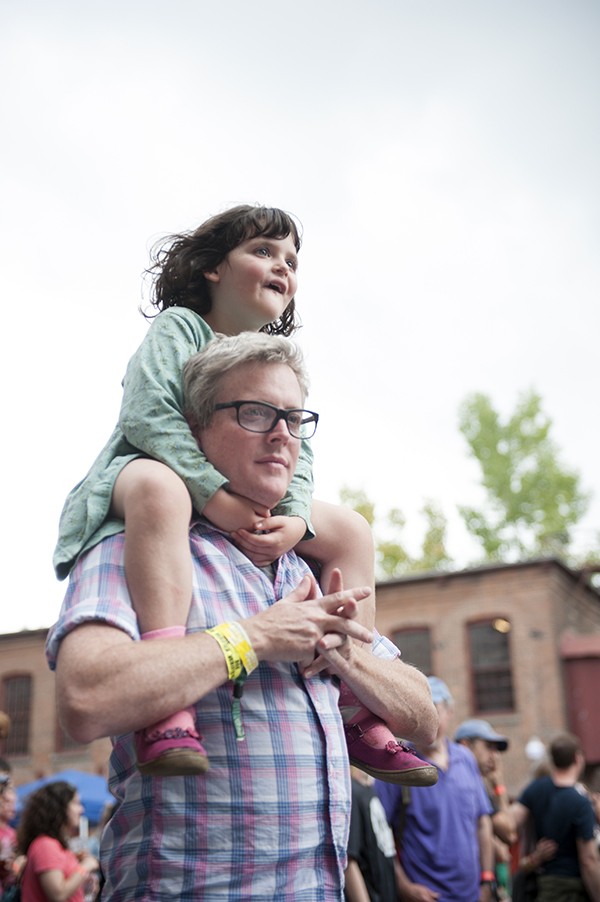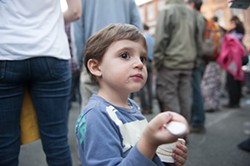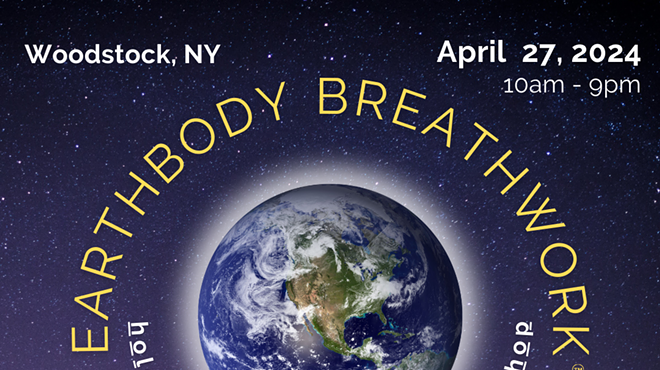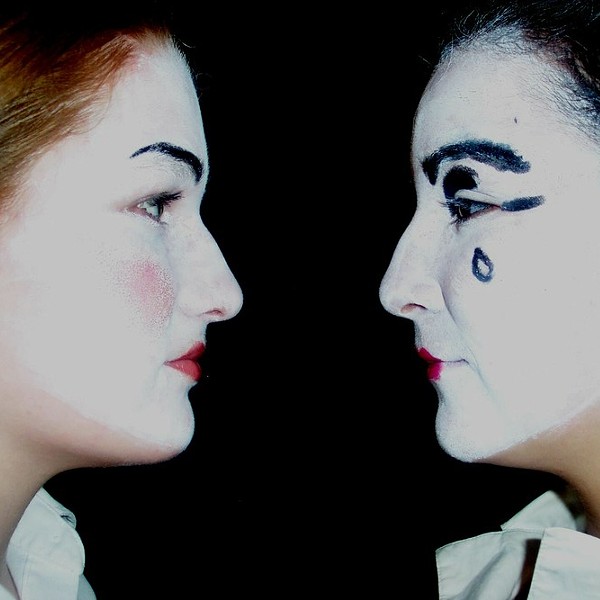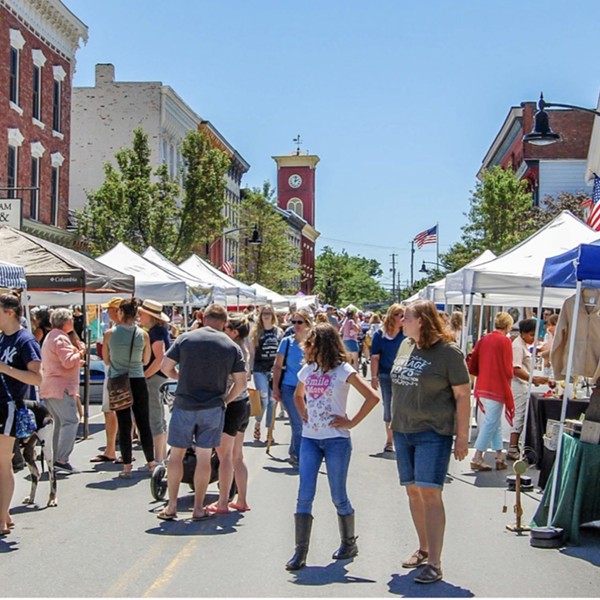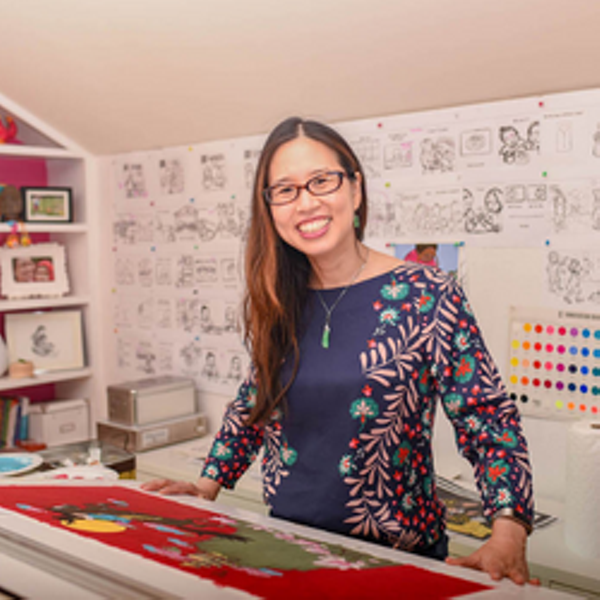When I looked over again at the stroller, I could immediately see, even through that ocean of darkness, that my two-year-old son was gone. "Where's Iggy?" I shouted over the music to my group. I began frantically scanning their blank faces until my 11-year-old started to cry and clutched her little sister tightly. My husband's flashlight was already beaming between people on the hill where the kids had been playing at sunset. "We'll stay with the kids here while you look," my friend said, corralling my daughters close to his.
I turned in the opposite direction, trying to decide where Iggy might go. Among the thousands of people, the pathways between their blankets presented hundreds of options, and a rush of overwhelm threatened to flatten me. I suddenly wished I hadn't dressed Iggy in dark clothes that morning, or that we'd left before the last band. Then, I was walking toward the light of the food truck court, and unexpectedly, Iggy appeared in the middle of it, wandering slowly. I hurried toward him, and when I pressed my face to his, he was still silently trying to recognize me.
What was I thinking? When I approached Ani DiFranco to buy a CD after her set on a small stage at my first Clearwater Festival, I knew I preferred that experience to seeing music in anonymous concert spaces. Even in the mud of Woodstock '94, I was happier than at some smoky bar. I loved seeing A Tribe Called Quest and the Beastie Boys, my favorite bands at the time, take turns on a Lollapalooza stage. I loved looking at the festival lineup on the drive there, friends in each other's laps and stuffed into the car's hatchback. It was just how Woodstock, the town that raised me in the folds of drum circles formed on the village green, probably always wanted it to be.
Festivals hold promise in their paper wristbands. We walk their grounds because there's the possibility of happening upon something amazing. It might be the only time we go camping with a group of friends. It might be the only time we eat fried dough. And we bring our kids with us because a festival is a micro-utopia, where a community is built around similar interests and goals, even if just for the weekend, and where the boundary lines between people are more penetrable.
It's not like the stuff that's labeled "family fun," but is really just for the kids. Festivals are about exposure and discovery, but also about spending time together. Just like when you travel, festivals take you out of your element and into the adventure of finding a bathroom or something the kids will eat, which ultimately knits your group tighter as you experience something together.
That's what I was thinking about when I rented the alumni house at Bennington College with friends, so our families could spend a weekend with bluegrass and art at FreshGrass, held each September at MASS MoCA. We hoped to discover new music, new food, and to have some time together to play outside.
Living the Weekend Pass
FreshGrass is a big festival, so we chose a go-to spot in the back, where the sound of our tantrums, games, or quick getaways would dissipate quickly before bothering anybody. It turned out to be right behind the food truck that sold mac-and-cheese spring rolls, a score unto itself. One of us was always there, enjoying whatever happened on the main stage, while others meandered off on personal missions. Between the food, the open museum, and the three stages of music, we never even made it to the kids' tent.
Because we had weekend passes, we picked our moments—when there was something we wanted to catch, or a good time of day for the kids to enjoy it—and we stayed only as long as the kids were happy. Going to a festival as a family is about balance. Sometimes the kids need to do what the parents want; sometimes the parents do what the kids want. We got to know our limits, and scheduled departures so it didn't leave our festivaling on a sour note.
There was a moment when my 11-year-old and I found a spot at the small stage in Courtyard D, and Valerie June's music reverberated against the old brick factory walls. My daughter smiled, engulfed in this new music, with the hush of hundreds of bodies around us, and we watched the blue sky darkening above us like a James Turrell art piece. It proved addictive.
Ultimately, the thing we love about going to festivals together is the experience of being with so many people. As my friend Jenny says, "You have to believe that there's something wonderful that you will see, hear, experience—not in spite of—but because there are so many people." When FreshGrass got dark, the family next to ours pulled out glow sticks to share. We enjoyed the hayride at the Hawthorne Valley Fall Festival because we were sitting across from smiling strangers. At the Winter Hoot, a small festival in a compact space that's more like a sprawling party, we let the kids travel in a pack, and coordinated watching the gaggle with the other adults we knew or met there.
When the Summer Hoot family next to ours pulled out inflatable beach balls (brilliant because they can be easily stored), we joined in the game and made festival friends. We had first walked around the Ashokan Center, exploring the little village vendor area, making a mental note of our food options, blacksmithing demo times, and sweet treats that we'd mete out at various junctures throughout the day to keep the kids reaching. We pointed out landmarks so they could feel oriented and always find us if we got separated. Then we settled into a spot on the hill, where we could see the two stages, as well as the kids' tent at the top, full of activities and volunteers. It was the perfect perch, where the kids could ebb and flow between watching the festival from afar or rumbling into the crowd to get in on the action, as the mood struck over the hours we spent there.
When we left FreshGrass for the last time, Iggy in arms and the girls in tow, I spied a little one just entering, wearing a glow-in-the-dark skeleton costume. Aha!
The Magical, Musical Night
Something beautiful happened when the singer Elizabeth Mitchell was organizing the kids' tent at the Newport Folk Festival in 2013. Musicians who were playing that weekend did half-hour sets in the tent while the main stage was being reset for the next band. It wasn't especially advertised, just a mention in the info section of the website, with more on hand at the actual festival. But for Hurley resident Ruthy Ungar of the band, Mike + Ruthy, the kids' tent was where it was at. "It ended up being these really intimate sets," Ungar smiles, remembering its mellow vibe. "You could hang out in that one spot for the whole weekend and continually see bands."
When Ungar and Merenda were on tour a decade ago with The Mammals, she'd marveled at the huge teen scene at the roots festivals in Michigan. "They weren't coming because so-and-so had a hit song," Ungar says. "They came because they'd been coming since they were five, and they wanted to see their festival friends." It inspired them to organize the Winter and Summer Hoots at the Ashokan Center in February and August.
There's a campsite at the Ashokan Center that's dedicated to burying music deep into kids' cells. Originally called the Noisy Campground, the name was changed when a blogger suggested a more apt name: The Magical, Musical, All-Night Campground. That's often a major choice for Ungar's family: camp or hotel? It can be helpful to have your own space at night, but the idea of a festival is to become immersed in the world that's created there. "Sometimes camping is better than you thought it would be," Ungar muses. "You want kids falling asleep to live music played by their neighbor. That's something everyone should do."
Having grown up going to lots of festivals with her folk musician parents, Lyn Hardy and Jay Ungar, and stepmom, Molly Mason, Ungar credits those early experiences with her love of music. She didn't even want to play the fiddle until she was in her 20s. "But then it was all there," she says. "It's different when your whole family does something together. You just kind of absorb it." At Newport, Ungar strapped her toddler, Opal, to her back while playing on stage with husband Mike Merenda. Their son, Willy, played banjo, and with his suit and bowler hat, he quickly became a festival celebrity. "There were core moments where he was a kid, though." Ungar recalls how he'd also ask to go home. "It's the gamut of total involvement and having the best time, and then the pit of despair. But that's a five-year-old at home, too. You have to ride that wave with them."
In Ungar's must-pack festival kit, along with a small towel (because you never know), an umbrella (often a life-saving device), and ear protection (which can also help with sleep), is some way to take pictures. "They'll want to know they were there when they were that little."
Even if Ungar didn't work at and organize festivals, she would still go often with her family. "Festivals are a kind of social magnet. People come and they bring positive energy and intention . . . and kids can feel that. I think they need to feel that: a peaceful, joyous gathering of strangers and friends. It always strengthens my faith in humanity. We all need more community-building experiences like that."







